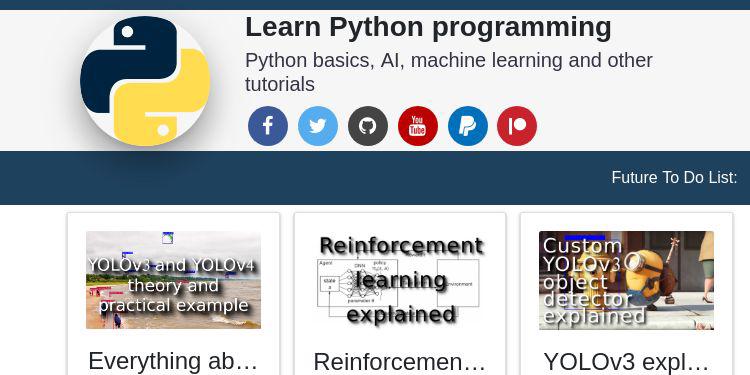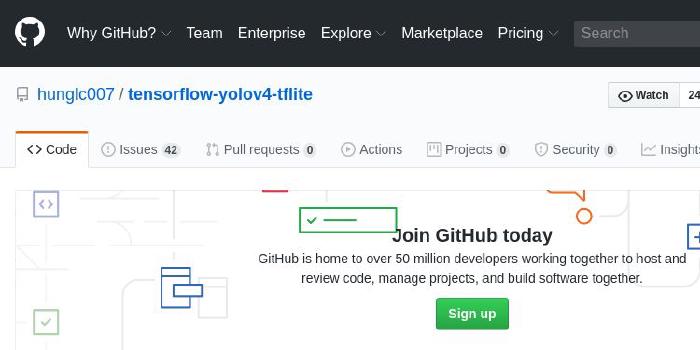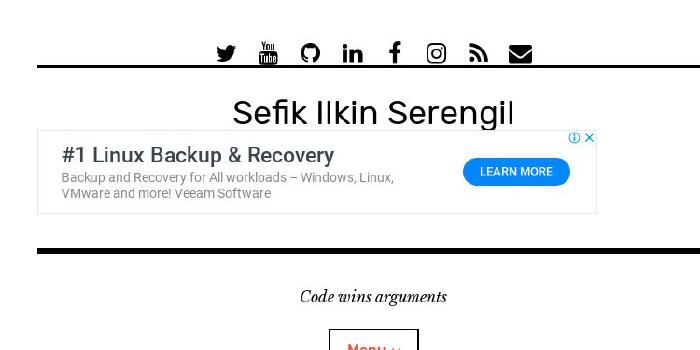pythonlessons/TensorFlow-2.x-YOLOv3

YOLOv3 implementation in TensorFlow 2.3.1
| repo name | pythonlessons/TensorFlow-2.x-YOLOv3 |
| repo link | https://github.com/pythonlessons/TensorFlow-2.x-YOLOv3 |
| homepage | https://pylessons.com/ |
| language | Jupyter Notebook |
| size (curr.) | 72448 kB |
| stars (curr.) | 174 |
| created | 2020-04-21 |
| license | MIT License |
TensorFlow-2.x-YOLOv3 and YOLOv4 tutorials
YOLOv3 and YOLOv4 implementation in TensorFlow 2.x, with support for training, transfer training, object tracking mAP and so on… Code was tested with following specs:
- i7-7700k CPU and Nvidia 1080TI GPU
- OS Ubuntu 18.04
- CUDA 10.1
- cuDNN v7.6.5
- TensorRT-6.0.1.5
- Tensorflow-GPU 2.3.1
- Code was tested on Ubuntu and Windows 10 (TensorRT not supported officially)
Installation
First, clone or download this GitHub repository. Install requirements and download pretrained weights:
pip install -r ./requirements.txt
# yolov3
wget -P model_data https://pjreddie.com/media/files/yolov3.weights
# yolov3-tiny
wget -P model_data https://pjreddie.com/media/files/yolov3-tiny.weights
# yolov4
wget -P model_data https://github.com/AlexeyAB/darknet/releases/download/darknet_yolo_v3_optimal/yolov4.weights
# yolov4-tiny
wget -P model_data https://github.com/AlexeyAB/darknet/releases/download/darknet_yolo_v4_pre/yolov4-tiny.weights
Quick start
Start with using pretrained weights to test predictions on both image and video:
python detection_demo.py
Quick training for custom mnist dataset
mnist folder contains mnist images, create training data:
python mnist/make_data.py
./yolov3/configs.py file is already configured for mnist training.
Now, you can train it and then evaluate your model
python train.py
tensorboard --logdir=log
Track training progress in Tensorboard and go to http://localhost:6006/:
Test detection with detect_mnist.py script:
python detect_mnist.py
Results:
Custom YOLOv3 & YOLOv4 object detection training
Custom training required to prepare dataset first, how to prepare dataset and train custom model you can read in following link: https://pylessons.com/YOLOv3-TF2-custrom-train/ More about YOLOv4 training you can read on this link. I didn’t have time to implement all YOLOv4 Bag-Of-Freebies to improve the training process… Maybe later I’ll find time to do that, but now I leave it as it is. I recommended to use Alex’s Darknet to train your custom model, if you need maximum performance, otherwise, you can use my implementation.
Google Colab Custom Yolo v3 training
To learn more about Google Colab Free gpu training, visit my text version tutorial
Yolo v3 Tiny train and detection
To get detailed instructions how to use Yolov3-Tiny, follow my text version tutorial YOLOv3-Tiny support. Short instructions:
- Get YOLOv3-Tiny weights:
wget -P model_data https://pjreddie.com/media/files/yolov3-tiny.weights - From
yolov3/configs.pychangeTRAIN_YOLO_TINYfromFalsetoTrue - Run
detection_demo.pyscript.
Yolo v3 Object tracking
To learn more about Object tracking with Deep SORT, visit Following link. Quick test:
- Clone this repository;
- Make sure object detection works for you;
- Run object_tracking.py script
YOLOv3 vs YOLOv4 comparison on 1080TI:
YOLO FPS on COCO 2017 Dataset:
| Detection | 320x320 | 416x416 | 512x512 |
|---|---|---|---|
| YoloV3 FPS | 24.38 | 20.94 | 18.57 |
| YoloV4 FPS | 22.15 | 18.69 | 16.50 |
TensorRT FPS on COCO 2017 Dataset:
| Detection | 320x320 | 416x416 | 512x512 | 608x608 |
|---|---|---|---|---|
| YoloV4 FP32 FPS | 31.23 | 27.30 | 22.63 | 18.17 |
| YoloV4 FP16 FPS | 30.33 | 25.44 | 21.94 | 17.99 |
| YoloV4 INT8 FPS | 85.18 | 62.02 | 47.50 | 37.32 |
| YoloV3 INT8 FPS | 84.65 | 52.72 | 38.22 | 28.75 |
mAP on COCO 2017 Dataset:
| Detection | 320x320 | 416x416 | 512x512 |
|---|---|---|---|
| YoloV3 mAP50 | 49.85 | 55.31 | 57.48 |
| YoloV4 mAP50 | 48.58 | 56.92 | 61.71 |
TensorRT mAP on COCO 2017 Dataset:
| Detection | 320x320 | 416x416 | 512x512 | 608x608 |
|---|---|---|---|---|
| YoloV4 FP32 mAP50 | 48.58 | 56.92 | 61.71 | 63.92 |
| YoloV4 FP16 mAP50 | 48.57 | 56.92 | 61.69 | 63.92 |
| YoloV4 INT8 mAP50 | 40.61 | 48.36 | 52.84 | 54.53 |
| YoloV3 INT8 mAP50 | 44.19 | 48.64 | 50.10 | 50.69 |
Converting YOLO to TensorRT
I will give two examples, both will be for YOLOv4 model,quantize_mode=INT8 and model input size will be 608. Detailed tutorial is on this link.
Default weights from COCO dataset:
- Download weights from links above;
- In
configs.pyscript choose yourYOLO_TYPE; - In
configs.pyscript setYOLO_INPUT_SIZE = 608; - In
configs.pyscript setYOLO_FRAMEWORK = "trt"; - From main directory in terminal type
python tools/Convert_to_pb.py; - From main directory in terminal type
python tools/Convert_to_TRT.py; - In
configs.pyscript setYOLO_CUSTOM_WEIGHTS = f'checkpoints/{YOLO_TYPE}-trt-{YOLO_TRT_QUANTIZE_MODE}–{YOLO_INPUT_SIZE}'; - Now you can run
detection_demo.py, best to test withdetect_videofunction.
Custom trained YOLO weights:
- Download weights from links above;
- In
configs.pyscript choose yourYOLO_TYPE; - In
configs.pyscript setYOLO_INPUT_SIZE = 608; - Train custom YOLO model with instructions above;
- In
configs.pyscript setYOLO_CUSTOM_WEIGHTS = f"{YOLO_TYPE}_custom"; - In
configs.pyscript make sure thatTRAIN_CLASSESis with your custom classes text file; - From main directory in terminal type
python tools/Convert_to_pb.py; - From main directory in terminal type
python tools/Convert_to_TRT.py; - In
configs.pyscript setYOLO_FRAMEWORK = "trt"; - In
configs.pyscript setYOLO_CUSTOM_WEIGHTS = f'checkpoints/{YOLO_TYPE}-trt-{YOLO_TRT_QUANTIZE_MODE}–{YOLO_INPUT_SIZE}'; - Now you can run
detection_custom.py, to test custom trained and converted TensorRT model.
What is done:
- Detection with original weights Tutorial link
- Mnist detection training Tutorial link
- Custom detection training Tutorial link1, link2
- Google Colab training Tutorial link
- YOLOv3-Tiny support Tutorial link
- Object tracking Tutorial link
- Mean Average Precision (mAP) Tutorial link
- Yolo v3 on Raspberry Pi Tutorial link
- YOLOv4 and YOLOv4-tiny detection Tutorial link
- YOLOv4 and YOLOv4-tiny detection training (Not fully) Tutorial link
- Convert to TensorRT model Tutorial link
- Add multiprocessing after detection (drawing bbox) Tutorial link
- Generate YOLO Object Detection training data from its own results Tutorial link
- Counter-strike Global Offensive realtime YOLOv4 Object Detection aimbot Tutorial link
To be continued… (not anytime soon)
- Converting to TensorFlow Lite
- YOLO on Android (Leaving it for future, will need to convert everythin to java… not ready for this)
- Generating anchors
- YOLACT: Real-time Instance Segmentation
- Model pruning (Pruning is a technique in deep learning that aids in the development of smaller and more efficient neural networks. It’s a model optimization technique that involves eliminating unnecessary values in the weight tensor.)







